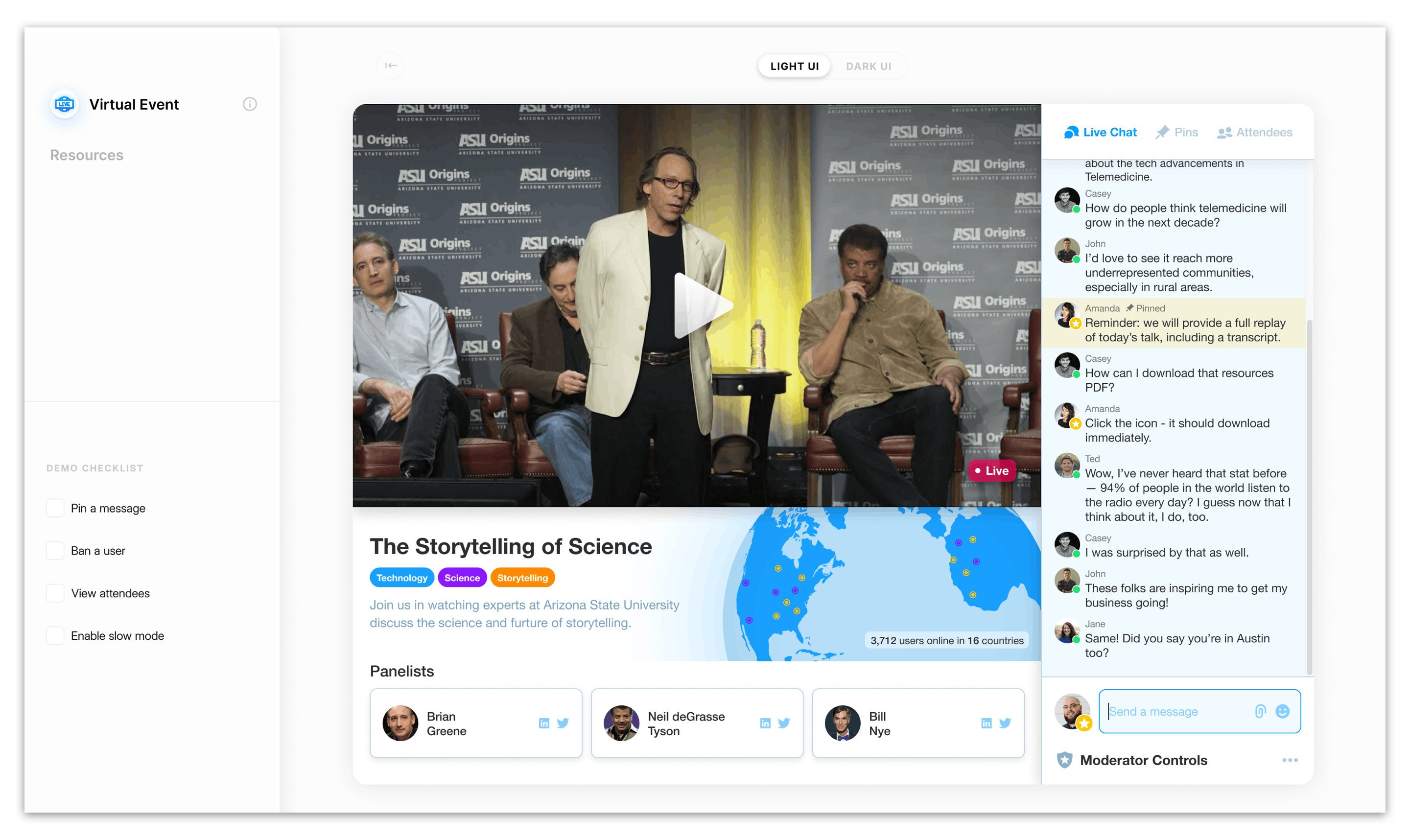Few industries experienced such recent meteoric growth as virtual events. Defined as an organized meet-up that takes place online rather than in a physical location, virtual events are a vital tool for event organizers in 2021 and beyond. According to a report by the Professional Convention Management Association, 70% of event organizers moved either all or part of their events to an online platform in 2020, augmenting the virtual event sector’s market potential.

The past year was tough for conference professionals, who rapidly pivoted business models as they canceled in-person events. They learned new skills, contended with a transformed event landscape, and selected virtual event platform partners to help their online gatherings be as engaging, entertaining, interactive, informative, and worthwhile for attendees and sponsors as possible. The transition to online platforms was positive for many events, allowing people from around the world to convene around a specific topic despite restricted travel and gatherings.
However, some virtual events missed the mark.
Frequent virtual event attendees likely suffered through Q&A sessions with minimal audience participation, navigated confusing virtual event software, remotely networked with people who were clearly replying to emails as they talked, and toggled between multiple tech tools such as Slack and Zoom to communicate with other attendees.
Video conferencing as a whole is a challenging medium — especially when connecting with strangers. “The distortions and delays inherent in video communication can end up making you feel isolated, anxious and disconnected,” writes Kate Murphy in The New York Times. “If you want to really communicate with someone in a meaningful way, video can be vexing.” As professional spheres shrink to the size of a computer screen for the foreseeable future, staying engaged on video chat is an uphill battle for virtual event tech providers.
All this is to say that despite their inherent benefits, sometimes virtual events are disappointing, and they fail to replicate the awe and excitement of their in-person counterparts.
But they don’t have to. “Virtual events can be a new delivery mechanism for communities to find each other,” explains Andrew Owen, head of community at Run The World, a virtual events platform that raised $10.8 million in 2020. “The reason why webinars and keynotes in an auditorium are so old fashioned is because they follow a model where there’s one person in the front of a room and an anonymous audience. Building community through virtual events lets a multitude of voices add to the conversation.”
As we look ahead to 2021, Stream interviewed CEOs, CTOs, founders, and product managers of top-of-their-field virtual event platforms to learn how they empower organizers to host online events that drive revenue, build community, spark new ideas, and leave event stakeholders — attendees, exhibitors, and sponsors — feeling inspired and engaged.
Accelevents: Boosting Interactivity Through Chat
A recent business model pivot allows Accelevents to boost engagement and track virtual event interactivity to power the future of virtual events.
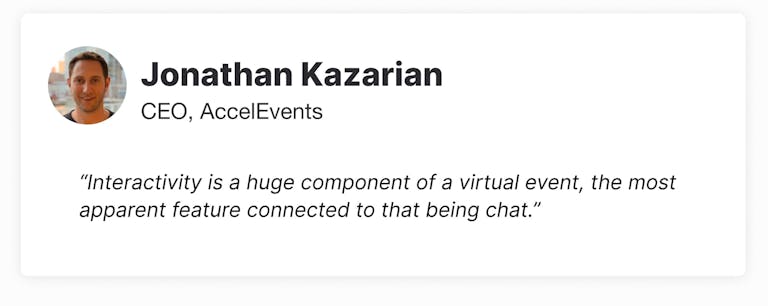
Initially founded as a tool to bridge the gap between in-person and online events, Accelevents rapidly pivoted to focus on serving online events in 2020. The company fortified their product’s functionality and now delivers digital experiences for over 12,500 organizations, conferences, trade shows, and more.
Here, Accelevents CEO Jonathan Kazarian talks about the top features virtual events platforms must implement, how to measure event success, and the importance of encouraging — and tracking — attendee engagement.
How has Accelevents evolved over the past year?
We launched six years ago, and as we grew, we became a full-service event tech stack, adding ticketing and processing. In March 2020, we made a quick pivot to focus on virtual events and create a platform with more functionality.
What issues were top of mind when you were transitioning your product to serve virtual events best?
Interactivity is a huge component of a virtual event, the most apparent feature connected to that being chat. We started looking into whether it made sense for us to build our own chat functionality. We explored using Google’s Firebase. But we also started looking at the solutions already out there that had the reliability and scalability we needed. Buying a chat solution made the most sense for us because we didn’t need to reinvent the wheel, and we didn’t need to worry about backend maintenance.
How do you measure event success?
Engagement is an important metric of event success. One way we can measure attendee engagement is through chat. How many people are there direct messaging during the event? How active are they in the main chat channels? We track the number of messages and frequency of posting in our networking chat “lounges” to evaluate an event’s success.
What makes Accelevents stand out from other virtual event solutions?
We provide a holistic experience for our end users and event organizers so they have everything they need under one roof. Having a full-featured chat functionality in addition to a full-featured video experience avoids making organizers set up a Slack group and a bunch of Zoom rooms for their attendees.
This makes a seamless experience for attendees, speakers, exhibitors, and event organizers.
What’s the best way to increase attendee engagement during events?
The content you’re producing is a big piece of the engagement puzzle, as is the way speakers interact with an audience. At the beginning of a presentation, speakers should get attendees to post in the public chat, such as question prompts: What’s their favorite food? What’s their dog’s name? Once you start getting people talking, they continue to chat, and feel more comfortable interacting with the content.
How will virtual events continue to evolve over the next ten years?
There are industry predictions out there that the virtual event space will grow tenfold over the next ten years, and I think that’s an understatement. In June 2020, virtual events were just being looked at as a replacement to in-person events. Today, we’re over that inflection point. Virtual events have made their own category.
Furthermore, they are another tool in the toolbox of marketers. As community continues to be a bigger aspect of how companies grow and succeed, the way they engage their customers and prospects becomes even more relevant and important. Virtual events will play a big role in this initiative.
In-person events are coming back, hopefully soon — I love in-person events. But virtual events are very much here to stay.
What do you hope the future of virtual events holds?
I’m excited about the continued expansion of virtual events, and the expansion into hybrid events that is yet to be defined. Virtual events have a huge opportunity to take communities that have been developed through in-person gatherings, and expand them to help people stay in touch and deepen their relationships.
Event Farm: A 3D Virtual Layout for Simulated Conferences
Next-level technology and smart messaging sends event engagement through the roof.
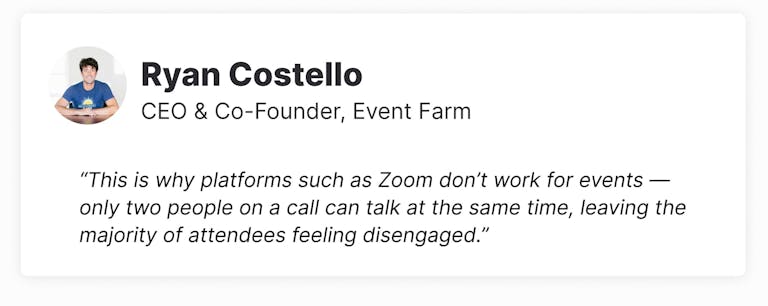
If you’ve ever played the video game The Sims, you already have an idea of how Event Farm’s The Echo technology works. Rather than experience an event through an online portal, Event Farm’s platform simulates the physical space of an in-person event and pairs a 3D exhibit hall with cutting-edge virtual event features, such as video, chat, text messages, Q&As, and more.
Here, Event Farm CEO and Co-Founder Ryan Costello talks about the potential for virtual event engagement, and why many virtual events fall flat.
How did Event Farm start, and how has it grown since it launched?
Event Farm really got its start over nine years ago in Washington, D.C. when I produced concerts for charity. The charity events were high profile, so I needed a way to create a non-transferable electronic ticket. I was a computer science major, so myself and a buddy of mine started coding to create ticketing software I could use to power my events — it wasn’t even a product, it was just a tool we used. Years later, we launched the ticketing software as a product for external event producers.
How has your business recently evolved?
In March 2020, our pipeline went to zero. All of our planned events were either canceled or postponed. We had to pivot, so we partnered with a company called VirBela, which creates a 3D virtual world where participants can create their own avatar. VirBela was originally designed to simulate a remote workplace, but we tweaked it to be appropriate for events such as expo halls, conferences, and live music. We call this technology The Echo.
Would you define the platform as virtual reality?
A little, but virtual reality usually implies the use of a headset. The Echo is a desktop application, so it’s accessible for everyone. Importantly, the technology has 3D spatial audio, so as I walk up to you in the virtual convention center, my speech gets increasingly louder, just like in a real event setting. Thousands of individual conversations can be had concurrently.
This is why platforms such as Zoom don’t work for events — only two people on a call can talk at the same time, leaving the majority of attendees feeling disengaged.
What are other ways Event Farm increases attendee engagement?
Our special sauce is event audience engagement. Text message notifications are a very important tool because it’s a communication channel that in-person events often use to drive attendee behavior. For example, event organizers can send reminder text messages that a keynote will start in 10 minutes; speakers can poll audience members to identify topics of interest.
Text messages are optimal because they don’t require an app to download. The adoption rate is through the roof.
How do you measure virtual event success?
Our trade show clients typically measure success by ROI. How many new leads did they or their sponsors/exhibitors make? For conferences and smaller meetings, it’s tougher to understand what success looks like. But if you have highly engaged attendees, they will be more likely to purchase a service or product. If you have highly engaged employees in a meeting, they’ll feel more connected to a company.
What will the future of virtual events hold?
You’re going to see hybrid events that feature both physical and virtual components. You’ll see smaller in-person and larger online events. There will be smaller networking events and break-out groups. General sessions and 1,000-person in-person keynotes just won’t happen anymore.
Toasty: A Quest to Create Meaningful Connections
Third-party tool integration for seamless collaboration is just one way Toasty makes virtual event lovers out of virtual event haters.
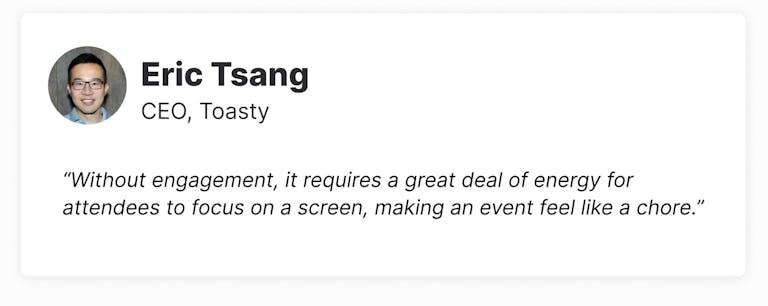
Initially conceived as an offline app to help in-person event attendees navigate conferences and trade show expo floors, the Hong Kong-based Toasty transitioned to a virtual event platform when the pandemic canceled most traditional events.
We caught up with Toasty CEO Eric Tsang to learn more about his mission to foster meaningful connections virtually.
You were forced to rapidly change your product after the pandemic disrupted in-person events. What was that process like?
Our team managed to pivot in a very short time in early 2020. Our first minimum viable product was rudimentary, but it served the purpose of enabling seamless online interactions. Fast forward to today, we are integrated with many common tools, and we’re changing the way people meet online. We’re trying to do this one connection at a time.
What other tools is Toasty currently integrated with?
Users of video chat may know that in order to use advanced collaboration tools, you must exit the application to open up a different collaboration tool. We wanted every feature to be available on the same platform. For example, Miro, a virtual whiteboard that many users can be in at the same time, dynamically allows our users to collaborate together. Miro is one of our integration partners available on our web app.
We also integrate with Google Docs so you can share documents instantly.
How many users does Toasty support?
Currently we support 2,000 users, but we haven’t yet invested in marketing. We have a strong product, however, and the potential is huge. The market is rapidly growing.
Who are your core customers?
We serve four major groups: professional teams, facilitators, educators and teachers, and community-building groups who regularly gather to talk about certain causes (such as local advocacy groups). We support both B2B and B2C models.
Why do you think many people do not enjoy virtual events?
People have a wide range of familiarity with technology. Some people are very tech savvy, and others are not. It’s very hard to serve those with different technological abilities.
Furthermore, without engagement, it requires a great deal of energy for attendees to focus on a screen, making an event feel like a chore. To have real interactivity, we believe there needs to be an element of fun and excitement in events. We have a number of activities event organizers can pick and choose to build their own agenda, such as question prompts, polls, ice breakers, team building activities, and more.
How do you measure event success?
We frequently measure events by qualitative metrics, such as how an attendee feels following the event. Would they recommend it to others? How likely are they to return to the event? Do attendees feel like they trust the event organizers? Did they receive value from the speakers?
What big challenges are virtual events contending with?
There’s a trend to view virtual events as a lesser experience than in-person events, so there’s pressure on event organizers to prove their virtual event’s value, and to lower the ticket cost.
While virtual events typically require lower (and sometimes free) ticket prices, the margins for event organizers are significantly greater because they don’t have to worry about event space, food, and on-site staff.
WebBabyShower: Celebrating Personal Life Events
Platform customization and tailored resources help hosts include friends and family on important life milestones.
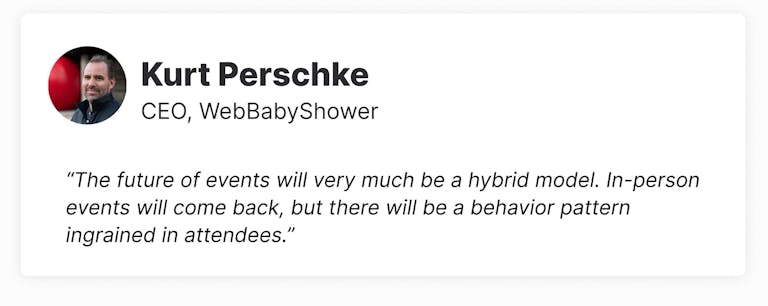
Virtual events aren’t just for B2B professionals. A growing number of online event users employ virtual platforms to host key life events. Whether it be a completely virtual gathering or a way to include family members who live far away, platforms such as WebBabyShower were created with family and friend gatherings in mind.
We sat down with the CEO of the virtual event platform WebBabyShower, Kurt Perschke, to learn more about what makes this oft-overlooked virtual event category tick.
How many customers does WebBabyShower support?
We have between 50,000 and 100,000 users on our platform per month. We’ve certainly seen a big spike in users since the pandemic, but our numbers were already increasing before March 2020. Remote baby showers, weddings and other personal life events were trending toward having digital components.
What does WebBabyShower offer event users that other platforms such as Zoom do not?
Unlike many virtual event platforms, we’re not looking to support B2B events. Our goal is to recreate a lifetime milestone. A lot of features we have are modeled after an in-person event. We have built-in baby shower games, photo albums, invitations, and personal websites with design offerings. However, for us value-add is not always feature based: It’s convenience, design, and having a solution that feels special.
How important is customization to your core users?
It’s a very important component because we’re trying to recreate something that happens in real life, where the host’s personality often shines. We recently did a massive redesign of our platform, and we had a huge bump in acquisition.
How does your platform best drive engagement?
Engagement is a big concern. Games help. But our online event product is often staged out over months so invitees can stay connected to expectant mothers and follow their progress. Weekly engagement matters more than a specific 90-minute event.
Our platform is unique in that attendee engagement is often reliant on the host, our paid user. We encourage hosts to engage their attendees by sending them targeted instructional content. The idea is to have hosts feel confident in our tool. We’re trying to get hosts to engage with another group, not necessarily with our product. The product should be as invisible as possible; the connections should shine.
Many folks are using virtual events for the first time. In a life event, such as a baby shower, you’re likely going to have older attendees, like grandparents. How do you facilitate rapid onboarding?
One way we address this is by providing content for different age groups (think: Grandma’s Guide to Video Chat). We send this content to the host (our paid user), who can send along these resources to their attendees so the host doesn’t have to explain everything.
Are there any SDK or APIs that WebBabyShower uses?
We have a tight integration with Vimeo, and we have several more coming online in the next few months. However, we’d like to integrate with more providers. We are currently in the market seeking more event-based APIs.
What is the future of the event industry?
The future of events will very much be a hybrid model. In-person events will come back, but there will be a behavior pattern ingrained in attendees. If people can’t make a flight or use vacation days from work, they will expect there to be a virtual event option.
On the event organizer side, they will recognize a continued opportunity to capture a virtual audience.
Welcome: A Five-Star Virtual Experience
Galas, keynotes, and charity events. How Welcome creates luxury virtual experiences.
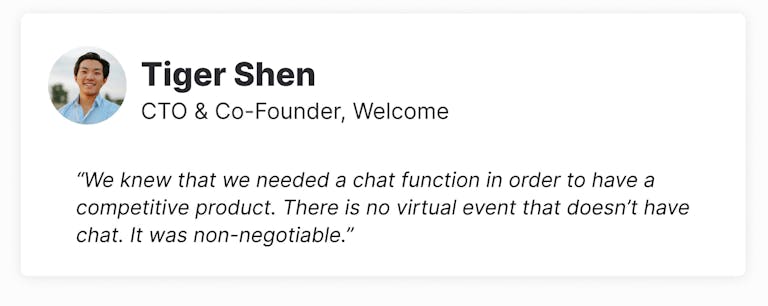
The first thing you see when you enter Welcome’s website is the tagline, “Create jaw-dropping virtual events.” With intuitive event layout, next-level features such as high-quality video, chat, green rooms for speakers, and more, event organizers can seamlessly deliver conferences, wine tastings, gala events, concerts, webinars, expos and much more.
Stream sat down with Welcome’s co-founder and CTO Tiger Shen to learn what makes Welcome stand out.
What’s Welcome’s elevator pitch? What makes the product different from similar virtual event platforms?
Welcome is the world’s first five-star virtual venue. If you think of hosting an in-person event, you have a selection of venues, such as the Ritz Carlton, Four Seasons, etc. Earlier this year, planners of high-end events contended with transferring their gathering online. This is the space that Welcome has come into. We pride ourselves on creating jaw-dropping experiences.
How has Welcome grown during the pandemic?
We’ve grown our headcount. Two months ago it was just myself and our co-founders in our rooms, and now we have upwards of 25 employees. It’s reactive hiring because we’re trying to keep up with demand. We founded the company in May 2020.
We as a founding team have our own events background, and we launched Welcome because we attended a bunch of virtual events and left every one of them with a bad taste in our mouths. We almost had secondhand embarrassment for the organizers who were stressed out and were juggling different platforms such as Zoom and Slack, etc. We wanted to build a platform that we would be proud to host our own events on.
What types of features are included in Welcome’s centralized virtual event space?
Using the analogy of an in-person venue, there is usually an auditorium and maybe a lobby lounge area where you can mingle, and a bar. There are different types of spaces for different use cases. While they don’t all map perfectly to a virtual event, some of the themes are the same.
So we have an area of our application called the auditorium, which is like a live television broadcast — essentially a video presentation — that has a chat where attendees can interact with the presenter. They can send emojis, and comment on prompts from the presenters. Another main part of the application are spaces for smaller group networking areas where attendees can make authentic connections. In these spaces, we aim to remove the awkwardness of jumping into a video chat with a presenter.
What main problem were you trying to solve when you integrated with Stream’s Chat API?
We knew that we needed a chat functionality in order to have a competitive product. There is no virtual event that doesn’t have chat. It was non-negotiable.
We knew we wanted to innovate in the event experience itself, such as the format of the venue and the presentation of the event. But as a co-founder, I didn’t want to reinvent the way chat messages are sent back and forth. I started evaluating different chat vendors, and Stream’s pre-built React SDK ended up being the quickest path I saw to an integration.
How do scalability and performance factor into your tech stack decisions?
Scalability wasn’t so much an initial concern, but it was once we launched. As we grew, we had a big milestone in late September 2020 when we committed to hosting a conference for 6,000 registrants. Prior to that, our biggest conference was 300. We signed the contract with the event organizers, and we thought about scaling all of our components — a big one being chat, because it’s always active.
Our team worked with Stream so by the time the event happened, there was a new performance-oriented component in the SDK, and it took me a few hours to plug it in. We had no issues with chat performance during the event.
What are the most important features to increase engagement?
It’s not so much about features. It’s about how everything plays together. You can’t check off a bunch of things a virtual event had and know whether it was a good event or a bad event. You have to attend the event and feel it. We have features like chat, graphic presentation, the ability to play pre-recorded videos, but I can’t point to any one of these and say, this is why people love Welcome.
There is a lot of art to running a good event. It’s not just having features, it’s more about what you do with them.
Interested in learning what Stream Chat can do for your virtual event? Try our free, 28-day Chat Trial!

